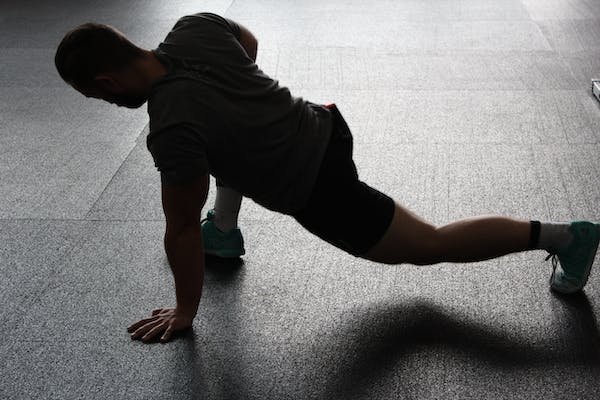
Most people are familiar with the two main types of stretching- dynamic and static. But most people don’t know that there are big differences between the two, and one is better than the other for achieving certain goals. So, what are the differences between dynamic and static stretching? Let’s find out!
What is Dynamic Stretching?
Dynamic stretching is a type of stretching that uses momentum to take your joints and muscles through their full range of motion. It is an active form of stretching that is often used as part of a warm-up routine.
While static stretching, which involves maintaining a posture for a lengthy amount of time, helps to prepare your body for activity by increasing heart rate and core temperature, dynamic stretching improves your body’s preparedness for activity by raising your heart rate and body temperature.
Furthermore, dynamic stretches enhance your range of motion and lower your odds of injury. Consequently, athletes and coaches lean more toward them than static stretches. If you have never done dynamic stretching before, fear not–there are various online instructional videos and articles that can show you the ropes.
What is Static Stretching?
When most people think of stretching, they think of moving their bodies into a position and holding it there for an extended period of time. This type of stretching is often referred to as static stretching. Static stretching is a great way to increase flexibility and range of motion. It involves slowly moving your body into a position and then holding that position for 20-30 seconds. You should feel a gentle stretch in the muscle, but you should not feel any pain. If you do feel pain, you may be overstretching the muscle. Static stretching is best done after a workout when your muscles are warm. You can also do static stretches before a workout to help prevent injuries.
What is the Difference between Dynamic & Static Stretching?
While both dynamic and static stretching involves stretching the muscles, there are some key differences between the two types of stretching.
Dynamic stretching is a form of active stretching that uses momentum to lengthen the muscles. It is often used as a warm-up before physical activity, as it helps to increase blood flow and heart rate.
Static stretching, on the other hand, is a form of passive stretching that involves holding a position for an extended period of time. It is often used after physical activity, as it helps to improve flexibility and range of motion. While both types of stretching are beneficial, choosing the right type of stretch for your needs is important.
Which Type of Stretching is Right For You?
There are a number of factors to consider when deciding whether dynamic or static stretching is right for you.
Warming Up
Dynamic stretching is a good option if you are looking for a way to warm up your muscles before physical activity. The active movement involved in dynamic stretches helps to increase blood flow and heart rate, making it an ideal way to prepare your body for exercise.
Improving Flexibility
If you want to increase your flexibility, static stretching is a good option. The extended period of time you spend holding a position in static stretching allows your muscles to lengthen slowly, improving your range of motion over time.
Preventing Injuries
While both dynamic and static stretching can help to prevent injuries, dynamic stretching is often thought to be more effective. This is because the active movement involved in dynamic stretching helps to increase your range of motion, making it less likely that you will strain a muscle during exercise.
Recovery
Both dynamic and static stretching can be used as part of a recovery routine. Static stretches are often used after physical activity, as they help to reduce muscle soreness. Dynamic stretches can also be used after exercise, but they are less likely to cause muscle soreness.
Improving Your Range of Motion
If you want to improve your range of motion, static stretching is generally the best option. This is because static stretching helps lengthen the muscles and tendons, leading to greater flexibility.
The Reason Why You’re Stretching Matters
When deciding whether to use dynamic or static stretching, it is important to consider why you are stretching. Dynamic stretching is a good option if you are looking for a way to warm up your muscles before exercise. On the other hand, static stretching is generally the best choice if you want to improve your flexibility or range of motion. And if you are interested in preventing injuries, dynamic stretching is often the best option.
Stretching for Sports
While dynamic and static stretching can both be beneficial for athletes, dynamic stretching is often thought to be more beneficial. This is because dynamic stretching helps improve the range of motion, making it less likely that you will strain a muscle during exercise. Dynamic stretching is also a good way to warm up your muscles before physical activity.
Stretching to Prevent Injuries
Dynamic stretching is often the best option if you are looking for a way to prevent injuries. The active movement involved in dynamic stretching helps increase your range of motion, making it less likely that you will strain a muscle during exercise.
How to Stretch Safely
Whether you are using dynamic or static stretching, it is important to stretch safely. When stretching, be sure to warm up your muscles first. This can help prevent injuries. Also, be sure to hold each stretch for at least 30 seconds. And remember to breathe deeply as you stretch.
When stretching, be sure to:
· Warm up your muscles first
· Hold each stretch for at least 30 seconds
· Breathe deeply as you stretch
· If you have any pain, stop stretching and see a doctor.
Final Thoughts
Both dynamic and static stretching can be beneficial. However, the best type of stretching for you depends on your goals. Dynamic stretching is a good option if you want to warm up your muscles before exercise. On the other hand, static stretching is generally the best choice if you want to improve your flexibility or range of motion. And if you are interested in preventing injuries, dynamic stretching is often the best option.



